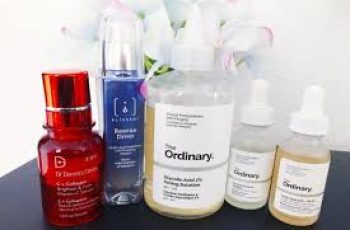
What Does Gluconolactone do in Skincare and What are its Benefits?
Gluconolactone, you’ve probably never heard of it before and I wouldn’t blame you for groaning at the thought of having to learn about yet another chemical exfoliant.
But I would be lying if I said this clever PHA is one to pass by.
This under the radar skin ingredient carries with it a lot of oomph and you’ll be amazed with the difference in the appearance of your skin, especially with gluconolactone being hailed the gentlest acid available on the market.
So, what is it about this gentle skin giant that makes it really stand out from the crowd, well that’s exactly what we are going to explore today.
What is gluconolactone?
As a member of the PHA family, gluconolactone is known for being the gentlest of the chemical exfoliants and has one of the largest molecule size meaning it is unable to penetrate very deeply
into the skin making it the best option for those who have sensitive skin, who still want to slough away the build-up of dead skin cells.
With all its benefits, the chances of finding active levels of gluconolactone in skincare formulations is unlikely, compared to the AHA and BHA powerhouse ingredient, such as glycolic acid and salicylic acid.
Having said that gluconolactone provides impressive support for the active ingredients allowing the skin to be exfoliated as well as locking in moisture into the skin.
These hydrating properties alone mean that introducing the PHA into your daily routine will benefit your skin enabling it to look and feel healthier.
What are the skin benefits of gluconolactone?
You will find that gluconolactone is a multi-tasking ingredient offering countless skin benefits and helping you achieve an overall flawless complexion.
Here are some of the main benefits you can expect to find when introducing this PHA into your routine.
Offers antioxidant properties to the skin
Studies have shown that the antioxidant properties of gluconolactone do not compare to those found in other ingredients, such as vitamins C and E.
Having said that gluconolactone is praised at its abilities to neutralise free radicals and the damage they can cause to the skin.
It is also able to bind together the free radicals encapsulating the damage caused from exposure to the sun, pollution, central heating and other environmental stresses.
Exfoliates the skin
With gluconolactone being a PHA, it is able to provide exfoliation to the skin by dissolving the bounds holding the layer of dead skin cells to the outer surface of the skin.
If these cells are left to build-up it can result in flaky, dry patches, dull looking skin with uneven texture.
You may also find that breakouts such as spots and blackheads develop which can become severe depending on the skin type you have, oily skin for example, can suffer from more frequent blemishes due to the excess sebum found in the pores.
Quite often other skin types that are sensitive and dry cannot use any form of chemical exfoliation without experiencing some form of skin irritation.
However, as previously mentioned, gluconolactone is very gentle and much like all PHAs can be used by those with hyper-sensitive skin and skin concerns such as eczema and rosacea.
You may find that common side effects, such as redness and irritation won’t occur compared to more potent chemical exfoliants such as glycolic and salicylic acid.
Hydrates the skin
One of the properties that make PHAs such as gluconolactone unique is the fact it is a humectant, meaning it is able to attract the water from the area surrounding the face and locking in that moisture into the skin.
This will keep your skin hydrated and looking full of bounce with fine lines and wrinkles notable reduced with a youthful looking complexion.
With the many skin benefits and the fact gluconolactone is so gentle you will find adding it into your skincare routine is very simple,
however, we must stress the importance of ensuring you first perform a patch test with any new product or ingredient that hasn’t been applied to your skin before.
If you have any further concerns about using gluconolactone then it is best to consult a doctor or trained professional.
How to use gluconolactone in your skincare routine
For some products, such as moisturisers the formulation is gentle enough to be applied twice a day.
This really depends on the particular product you decide to use when introducing gluconolactone in your daily skincare routine.
For more potent products, such as acid toners and peels it is best to limit how often you use them as it can cause irritation, especially if you have a sensitive skin type.
No matter which skin type you have, you may find your complexion will benefit from alternating products that contain complimentary ingredients that can be used safely with gluconolactone, such as hyaluronic acid and niacinamide.
For stronger ingredients such as retinoids and vitamin C that do not mix as easily with gluconolactone try applying them on different times of day, for example, vitamin C serum in the morning and a gluconolactone enriched serum in the evenings.
With this PHA being an humectant you will find that teaming hydrating products, such as serums, will boost the levels of moisture locked into the skin giving your complexion an all over more hydrated finish and luminous glow.
Dry patches will disappear and fine line and wrinkles will be ironed out with the skin gaining more bounce and any signs of skin sagging are lifted thanks to the hydration boost.
What are the side effects of gluconolactone?
Because gluconolactone is a PHA, there are very little, if any side effects to using it in your daily routine.
We must remember that it is still an acid and should be used with some caution, especially if your skin is sensitive or prone to eczema and dermatitis flare-ups.
When using an acid toner enriched in gluconolactone you can still expect to find your skin to appear red and flashed after application but should calm in a matter of minutes.
Dryness, stinging and itchiness should not occur and should you find you are suffering from these reactions it is advisable to stop using the product straight away.
I hope that today has given you a little insight into gluconolactone and the skin benefits you can expect to see when using it in your daily routine.
As we have previously discussed this clever PHA may not be a leading member of the formulation of your favourite skincare product,
however, it does play a vital part in taking your skincare to the next level of combating your skin concerns in rapid time.
If you are wanting to know more about PHAs in general, you can check out our blogpost about what polyhydroxy acids are and what are their skin benefits.


